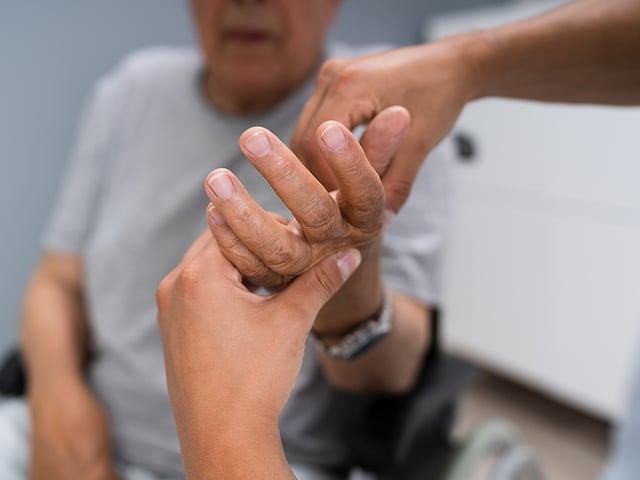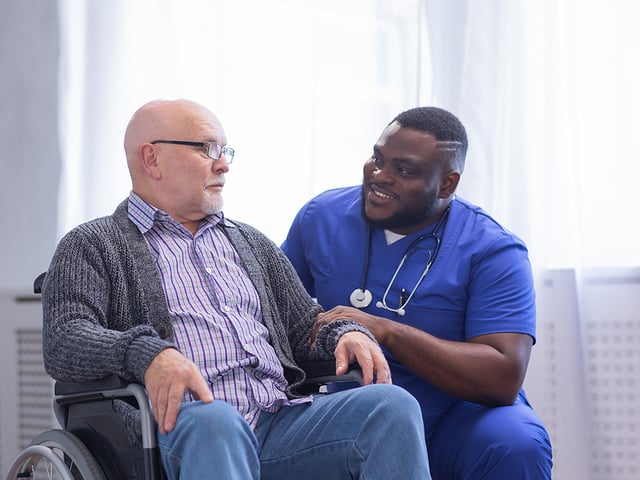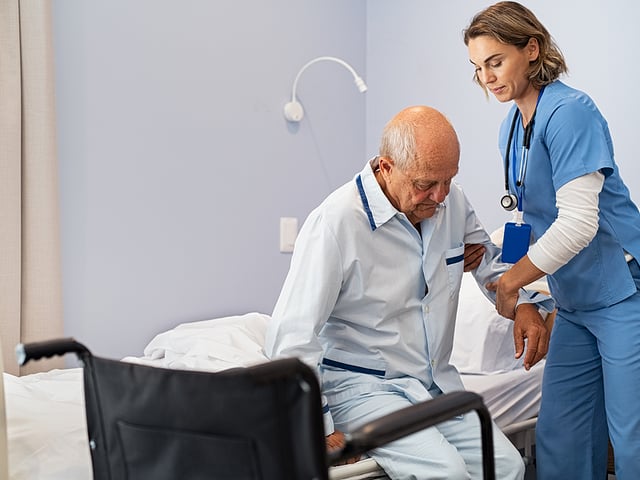
CNA Skills: Assisting with Personal Care Part 1
As a Certified Nursing Assistant (CNA), you play a vital role in the personal care of patients. Your duties often include some of the most fundamental day-to-day tasks that contribute greatly to the comfort, hygiene, and overall well-being of those in your care. This series will provide a detailed guide on how to effectively perform some of these tasks, focusing on five key personal care skills in each part. These are part of the 25 skills that potential CNAs must master for their skills test. In this blog, we’ll delve into the proper procedures for brushing dentures, providing mouth care, performing upper and lower body partial bed baths, and providing a back rub or massage.
The First Five Personal Care Skills
Be sure to follow Opening Procedure before starting each task and end with Closing Procedure.
Brushing Dentures
When attending to a patient with dentures, CNAs may be required to clean these crucial dental apparatus as part of the overall oral hygiene routine. It’s worth noting that dentures need to be handled with the utmost care to avoid damage, and they should always be stored in a denture cup when not in use to prevent accidental misplacement or disposal.
When preparing to clean dentures, you should start by donning gloves. Dentures can be slippery, and the use of gloves helps ensure a good grip. It’s also a necessary step to maintain hygiene and prevent the spread of germs.
Prior to removing the dentures from the cup, it is a good practice to line the sink with a small towel and fill it with some water. This way, should the dentures slip from your grasp, they will land on a soft surface, mitigating the risk of breakage.
Cleaning dentures involves brushing them as you would your own teeth, taking care to clean the areas that come in direct contact with the gums. Use warm water (not hot) combined with a denture cleaner or non-abrasive toothpaste. While the dentures are being cleaned, place them in an emesis basin so you can thoroughly clean the denture cup. Once cleaned, return the dentures to the cup, now filled with cool water, and complete the task by disposing of trash and performing the Closing Procedure.
Mouth Care
For unconscious patients, mouth care becomes a crucial part of the daily routine to maintain oral health. The technique used here is slightly different, requiring additional care to avoid causing harm or discomfort to the patient.
Before initiating mouth care, don gloves and ensure that the patient is positioned correctly to prevent aspiration of any fluids used during the process. Ideally, the patient should be on their side, or with their head raised to no greater than 30 degrees.
Next, protect the patient’s clothing or chest with a shield or covering to prevent them from getting wet during the process. Use a toothbrush or sponge-tipped applicator along with toothpaste to clean the patient’s mouth and tongue.
Rinse the patient’s mouth thoroughly, ensuring that you catch the fluid in an emesis basin and suction as necessary. Following the rinse, dry the patient’s face and mouth carefully, and if available, apply a lip lubricant to keep the lips moisturized and prevent cracking. Conclude the procedure by disposing of all used items appropriately and performing the Closing Procedure.
Upper Body Partial Bed Bath
Performing an upper body partial bed bath for unconscious or immobile patients is a significant part of a CNA’s responsibilities. This process not only helps maintain the patient’s hygiene but also provides a degree of comfort and dignity.
To perform an upper body partial bed bath, you must start with the Opening Procedure, which involves explaining the process to the patient (if possible), washing your hands, and ensuring the necessary supplies are gathered and easily accessible. These supplies include a basin filled with warm water, clean washcloths, soap, and a barrier to protect the bed linens from getting wet.
Next, you should place a bath blanket over the patient to maintain their warmth and privacy during the bath. It’s important to only uncover one area of the patient’s body at a time, thus ensuring their comfort and modesty.
Starting with the patient’s face, use a soapy washcloth to gently clean the area, making sure to pay attention to any skin folds or crevices where bacteria might accumulate. It’s important to use a different clean cloth for each area to prevent cross-contamination. Rinse each area well with a clean, wet washcloth after washing to remove all soap residue, and then pat dry with another clean towel. Following the face, you can move on to the neck, arms, chest, and back.
Once the upper body bath is complete, it’s important to ensure that the patient is comfortable, clean, and covered. Dispose of used linens and washcloths in the appropriate receptacle and perform the Closing Procedure, which includes checking the patient’s comfort, cleaning up the area, and washing your hands.
Lower Body Partial Bed Bath
Performing a lower body partial bed bath requires the same level of attentiveness and care as the upper body bath. The steps to follow are identical, but this time the focus shifts to the lower body.
Begin with the Opening Procedure, explaining the process to the patient, washing your hands, and gathering your supplies. Then place a bath blanket over the patient, uncovering only the area you intend to wash at any given time.
Start with the patient’s hips and move your way down to the legs and feet. As with the upper body bath, use a fresh, clean washcloth for each area, and ensure that you clean, rinse, and pat dry thoroughly. Take special care to cleanse and rinse areas with skin folds or crevices, as these are spots where bacteria can thrive.
Once the lower body bath is complete, verify that the patient is comfortable, clean, and covered. Dispose of used linens in the appropriate receptacle and perform the Closing Procedure.
Providing a Back Rub/Massage
A back rub or massage can be a comforting addition to a patient’s bath routine. It can help to alleviate tension, manage pain, and provide a soothing sensory experience, which can be especially beneficial for patients who may be experiencing discomfort or anxiety.
To begin the process of providing a back rub or massage, you should perform the Opening Procedure, which involves explaining the process to the patient, washing your hands, and ensuring the necessary supplies are gathered and easily accessible. These supplies generally include lotion, gloves, and a bath blanket. Donning gloves is an important step to ensure hygiene and safety.
Next, position the patient comfortably on their side, ensuring their modesty and warmth are maintained by covering them with a bath blanket. As with other personal care procedures, it’s important to only uncover the area that you will be working on to respect the patient’s privacy.
Before applying the lotion, warm it between your hands. This ensures a more pleasant sensation for the patient, as cold lotion can be startling or uncomfortable. Apply the lotion to the patient’s back and begin to gently rub in long, circular motions. Start from the lower back, work up to the upper back, and then return to the lower back again.
This process should be repeated for around three to five minutes, depending on the patient’s comfort and tolerance. Throughout the massage, maintain a dialogue with the patient to ensure they are comfortable and that the pressure of the massage is appropriate.
At the end of the massage, help the patient back into a comfortable position. Dispose of used linens in the appropriate receptacle and ensure the patient is covered with a sheet or blanket. To conclude, perform the Closing Procedure, which includes ensuring the patient’s comfort, cleaning up the area, and washing your hands.
Wrapping Up: Nailing the Basics of Personal Care
As a Certified Nursing Assistant (CNA), you’re the cornerstone of daily care for many patients. The ability to perform personal care tasks, such as those we’ve explored in this blog, ensures patients’ comfort and dignity are maintained throughout their healthcare journey. Your skills extend beyond mere technique, encompassing compassion, patience, and understanding. These five personal care skills—brushing dentures, mouth care, upper and lower body partial bed baths, and providing a back rub or massage—are foundational to effective CNA practice. By mastering these, you’re well on your way to providing excellent patient care and maintaining a high level of professionalism in your role as a CNA. We hope that this series proves helpful in your journey to becoming an adept, compassionate CNA. Remember, practice is the key to perfection—so keep practicing these skills until they become second nature! Stay tuned for the second part of our blog where we will cover the next set of essential personal care skills.
Keep Reading

Certified Nursing Assistant Exam Blog
How Long Does it Take to Become a CNA?
As a profession on the frontline of healthcare, Certified Nursing Assis…

Certified Nursing Assistant Exam Blog
How to Do Well on the CNA Skills Test
Over 1.3 million nursing assistants work in our healthcare system today…

Certified Nursing Assistant Exam Blog
What Does a Nursing Assistant (CNA) Do?
Are you interested in exploring medical careers? The healthcare industr…